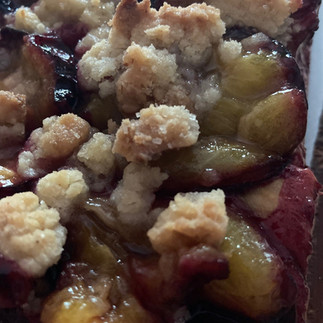The perfect plum tart, is, from Germany.
- ronnierennoldson
- Sep 11, 2022
- 4 min read
Updated: Sep 12, 2022
It’s been a while since I visited Germany, and one of the rituals I miss is that of afternoon kaffee und Kuchen. It’s a ritual that started when, during the 60’s, summer visits to my grandparents in Berlin always resulted in coffee, cake and schlag (Berlinisch for schlagsahne (which is so unlike English whipped cream primarily because it is professionally whipped and bought by the litre from the local bakerei))
Aunts, uncles, cousins and distant relatives would descend on the wohnhaus (or mietskaserne / tenement ) of the person whose turn it was to host the ritual and while the old ones talked in the sitting room, smoking cigars, drinking schnaps and catching up, or, as I later discovered discussing the impact of the installation of the berlin wall, we kinder (children) would have free rein of the rest of the house, running up and down the common stairs, playing in the still rubble-laden tenement courtyard, being shown how to halve an apple with just your finger nails by Regine (who only later I discovered was my half-sister) or avoiding the attention of Onkle Richardt with his one arm (apparently lost in the war but we didn’t believe him although we should have) his stinky cigar butts and rough face stubble until it was time for Kaffee und Kuchen!
It’s a ritual that helped me achieve a sense of contentment and of being grounded while everything else around was in turmoil and while the cigar butts and noise of an extended family are off the menu, it’s one I try to replicate whenever in Europe, whether at the café Americain in Amsterdam, or Nuria in Barcelona, café Sperl in Vienna ( ordering strudel mit schlag und Einspanner) or Rotenburg ob der Tauber where the bakerei offer the most fabulous cakes to take away or Gorlitz ( of The Grand Budapest hotel fame ) where the virtually untouched medieval city offers courtyard cafes with fresh fruit pastries. It’s an offer that is hard to replicate in a country where Greggs or Parsons only offer jam doughnuts, Danish pastries or flapjacks as their best.

So, I was delighted when a neighbour, with a glut of plums offered me a huge quantity and, once I made schnapps (see 2019 blog for more on this), I felt obliged to experiment and adapt recipes from cookbooks such as ‘gesse wird deheim; das kochbuch Badische landfrauen’ published by Ars Vivendi,‘Pastry’ by Richard Bertinet and ‘How to be a domestic Goddess’ by the lovely Nigella.
I came up with this: It’s not quite perfect yet, but actually only needs a background of German chattiness and summer afternoon warmth to achieve that but it’s as close as I can get to matching the sense of contentment of my childhood from a pastry while living in England.
Plum Tart aka Deutsche Pflaumenkuchen.
There are three parts to be made separately and assembled just before baking:
1: A heavily enriched bead dough base
2: Plums, stoned and halved marinated in their own juice and raw cane sugar and vanilla
3: A nutty crumble topping
Prepare:
1: The Mix 250 g strong white flour with 35g cane sugar, 25 g of soft butter and 5g yeast. Add 200 ml warm milk and water
Add half a beaten egg and knead for 10 minutes or until springy. Then then leave to prove under a towel for 60 minutes, meanwhile, pre-heat the oven to 190 C.
2: Half and stone 600g (about 15) large soft plums, dredge in raw cane sugar (cane sugar has a nice crunch and slightly molasses flavour but caster will work too), add a teaspoon of vanilla paste and mix together so that all the plums are covered in the sugar and vanilla. Leave aside while the base dough proves.
Now, grease a square, straight sided 9 inch loose bottomed cake tin, flour the base and line the sides.
3. Mix 25g plain flour, with25g soft butter, 25g of cane sugar and 25g crushed walnuts until it forms a dryish ball of dough. Then roughly break the dough apart and set aside.
Assemble:
Once the dough has proved, push the dough onto a lightly floured worktop until slightly larger than the base of your 9-inch baking tin, use fingers for this, not a rolling pin, leaving finger imprints in the dough rather like focaccia.
Place the dough into the baking tin pushing into corners, align plum halves in rows, cut side up, pushing lightly into the dough and pour any remaining sugar syrup over the top. Sprinkle small lumps of crumble topping across the plums (avoid fully covering the plums as the crumble needs to become crunchy) and, finally, sprinkle more cane sugar over the top.
Bake
Place tin onto a shelf in the middle of the over and bake for 30 minutes at 190 C and the crumble is golden.
Leave in the tin to cool for 5 minutes, then, having eased the sides with a palette knife, push out of the tin and leave to fully cool on the loose base of the baking tin on a cooling rack.
Transfer to a wooden bread board while sliding the tart off the loose baking tin base and remove the greaseproof lining.
Und da ist es: Wunderschone Deutsche pflaumenkuchen. Zum Wohl!
















Comments